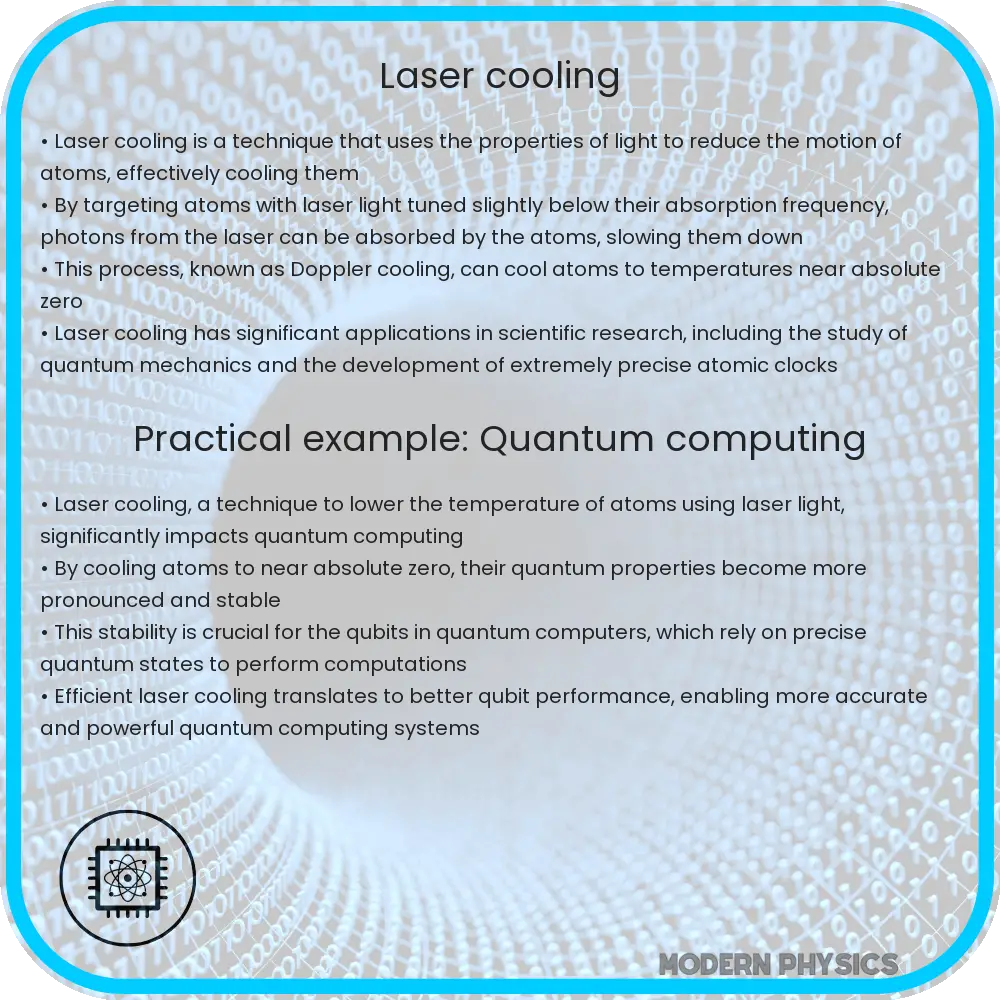Laser cooling uses laser light to reduce the temperature of particles like atoms or ions, advancing atomic physics and technology.

Introduction to Laser Cooling
Laser cooling is a fascinating application of physics that involves using laser light to lower the temperature of particles, typically atoms or ions. This remarkable technique has revolutionized the field of atomic physics, enabling scientists to study atomic properties with high precision and leading to advancements such as atomic clocks and quantum computers.
Principles of Laser Cooling
The foundational principle behind laser cooling is the manipulation of an atom’s momentum using photons, the basic units of light. Each photon carries momentum, and when a photon is absorbed by an atom, it imparts this momentum to the atom. Similarly, when the atom subsequently emits a photon, it loses momentum. If this process is controlled such that the absorption and emission of photons result in a net reduction in the atom’s kinetic energy, the atom’s temperature decreases.
The most common method of laser cooling is called Doppler cooling. The principle of Doppler cooling relies on the Doppler effect, where the frequency of light changes relative to an observer based on the source’s velocity towards or away from the observer. In the context of laser cooling, lasers are tuned to a frequency slightly below the natural resonance frequency of the atoms. As atoms move towards the laser source, due to the Doppler effect, the frequency of the laser light increases in the frame of reference of the atoms, pushing it closer to resonance and making it more likely for the atoms to absorb the laser light.
After absorbing the light, atoms emit photons spontaneously in random directions. On average, the emission of photons does not change the velocity of the atoms because it is equally probable in any direction. However, the absorption process is not symmetric; it slows the atoms moving towards the laser because the counter-propagating laser beam primarily affects these atoms. This directional preference in absorption but randomness in emission results in an overall reduction in the atoms’ kinetic energy, thus cooling them down.
Techniques in Laser Cooling
Beyond Doppler cooling, several other techniques contribute to the field of laser cooling, each tailored to different research needs and experimental setups.
- Magneto-optical Trap (MOT): Combining magnetic fields with laser cooling, the MOT is able to trap and cool atoms at the intersection of several laser beams and a magnetic field gradient. This technique is highly effective for cooling alkali metals and some alkaline earth metals.
- Sub-Doppler Cooling: The techniques under this category, including polarization gradient cooling or Sisyphus cooling, work to cool atoms to temperatures even below those achievable with basic Doppler cooling. These methods typically use spatially varying polarization of laser beams to manipulate the atomic states further and decrease their kinetic energy.
- Evaporative Cooling: Used primarily in conjunction with other laser cooling techniques, evaporative cooling involves selectively allowing the hottest atoms in a trapped gas to escape, which leads to a reduction in the average kinetic energy of the remaining atoms.
- Sideband Cooling: This technique is used mainly in ion traps and involves using radiation pressure to cool vibrational modes of motion in trapped ions. By selectively addressing specific vibrational sidebands, this method can cool ions to their ground state.
Each of these techniques leverages unique interactions between light and atoms to achieve lower temperatures, demonstrating the versatility of laser cooling methods in various scientific research fields.
Applications of Laser Cooling
Laser cooling has widespread applications in scientific research and technology development. Some of the most significant applications include:
- Atomic Clocks: Laser cooling is crucial for the operation of atomic clocks, which are the most accurate timekeeping devices known. By cooling atoms to near absolute zero, their quantum mechanical properties can be measured with extraordinary precision, which is vital for maintaining the standard definition of the second.
- Quantum Computing: Cold atoms are used as qubits in quantum computers. Laser cooling is essential to prepare these qubits in their lowest energy states, where quantum effects such as superposition and entanglement can be utilized to perform computational tasks far beyond the capabilities of classical computers.
- Bose-Einstein Condensate (BEC) Creation: Laser cooling techniques enable scientists to achieve temperatures necessary to study Bose-Einstein condensates, a state of matter that occurs at close to absolute zero, showcasing unique quantum phenomena on a macroscopic scale.
- Research in Fundamental Physics: Laser-cooled atoms are excellent candidates for precision tests of fundamental physical theories, including tests of the theory of relativity and searches for new forces or particles beyond the Standard Model of particle physics.
Future Prospects in Laser Cooling
As technology progresses, the scope of laser cooling continues to expand, promising exciting future developments. Innovations in laser technology and new cooling methods could lead to even lower temperatures and higher control over atomic states. Additionally, the integration of laser cooling with other technological advancements like nanotechnology and materials science could unlock new applications in computing, simulations, and even everyday technology.
Conclusion
Laser cooling is a pivotal technique in modern physics that manipulates the atomic motion using laser light to achieve ultra-low temperatures. From the basic principles of Doppler cooling to advanced techniques like sideband cooling, laser cooling has proven to be instrumental in advancing areas such as quantum computing and atomic timekeeping. As the field continues to evolve, the continued development of laser cooling promises to push the boundaries of what is scientifically possible, contributing to both theoretical insights and practical applications in numerous technical and scientific fields.
